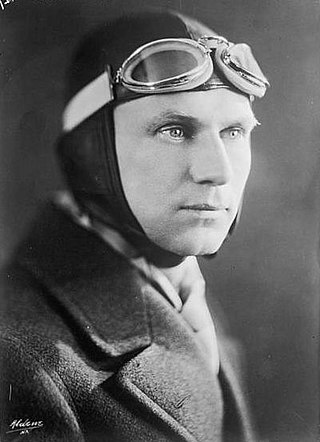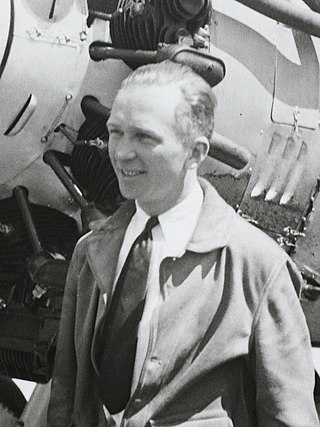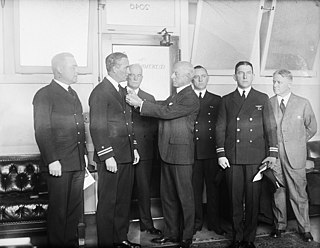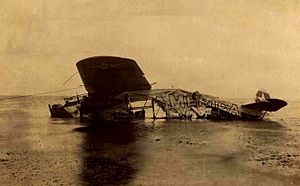
Richard Evelyn Byrd Jr., an American naval officer, was a pioneering American aviator, polar explorer, and organizer of polar logistics. Aircraft flights in which he served as a navigator and expedition leader crossed the Atlantic Ocean, a segment of the Arctic Ocean, and a segment of the Antarctic Plateau. He is also known for discovering Mount Sidley, the largest dormant volcano in Antarctica.

The Orteig Prize was a reward offered to the first Allied aviator(s) to fly non-stop from New York City to Paris or vice versa. Several famous aviators made unsuccessful attempts at the New York–Paris flight before the relatively unknown American Charles Lindbergh won the prize in 1927 in his aircraft Spirit of St. Louis. However, a number of people died who were competing to win the prize. Six men died in three separate crashes, and another three were injured in a fourth crash. The Prize occasioned considerable investment in aviation, sometimes many times the value of the prize itself, and advancing public interest and the level of aviation technology.

John Alcock and Arthur Brown were British aviators who, in 1919, made the first non-stop transatlantic flight. They flew a modified First World War Vickers Vimy bomber from St. John's, Newfoundland, to Clifden, County Galway, Ireland. The Secretary of State for Air, Winston Churchill, presented them with the Daily Mail prize for the first crossing of the Atlantic Ocean by aeroplane in "less than 72 consecutive hours". A small amount of mail was carried on the flight, making it the first transatlantic airmail flight. The two aviators were awarded the honour of Knight Commander of the Most Excellent Order of the British Empire (KBE) by King George V at Windsor Castle a week later.

The Bremen is a German Junkers W 33 aircraft that made the first successful transatlantic aeroplane flight from east to west on April 12 and 13, 1928.

Ver-sur-Mer is a commune in the Calvados department and Normandy region of north-western France. It is situated at the eastern end of Gold Beach between Arromanches and Courseulles. The town lies 20 km north-west of Caen and 14 km north-east of Bayeux.

Bernt Balchen was a Norwegian pioneer polar aviator, navigator, aircraft mechanical engineer and military leader. A Norwegian native, he later became an American citizen and was a recipient of the Distinguished Flying Cross.

Bertrand Blanchard Acosta was a record-setting aviator and test pilot. He and Clarence D. Chamberlin set an endurance record of 51 hours, 11 minutes, and 25 seconds in the air. He later flew in the Spanish Civil War in the Yankee Squadron. He was known as the "bad boy of the air". He received numerous fines and suspensions for flying stunts such as flying under bridges or flying too close to buildings.

Floyd Bennett was a United States Naval Aviator who, along with then USN Commander Richard E. Byrd, made the first flight to the North Pole in May 1926. However, their claim to have reached the pole is disputed.
Herbert Hollick-Kenyon was a British aircraft pilot who made significant contributions towards aviation in Antarctica.

The Southern Cross is a Fokker F.VIIb/3m trimotor monoplane that was flown by Australian aviator Charles Kingsford Smith, Charles Ulm, Harry Lyon and James Warner in the first-ever trans-Pacific flight to Australia from the mainland United States, a distance of about 11,670 kilometres (7,250 mi), in 1928.

The Fokker F.VII, also known as the Fokker Trimotor, was an airliner produced in the 1920s by the Dutch aircraft manufacturer Fokker, Fokker's American subsidiary Atlantic Aircraft Corporation, and several other companies under license. It was an airliner that could carry 6-12 people, depending on the version, and it used a variety of engines;early versions had one engine but three was more common.

Clarence Duncan Chamberlin was an American pioneer of aviation, being the second man to pilot a fixed-wing aircraft across the Atlantic Ocean, from New York to the European mainland, while carrying the first transatlantic passenger.

Charles Albert Levine was the first passenger aboard a transatlantic flight. He was ready to cross the Atlantic to claim the Orteig prize but a court battle over who was going to be in the airplane allowed Charles Lindbergh to leave first.

George Otto Noville, also known as "Noville" and "Rex," was a pioneer in polar and trans-Atlantic aviation in the 1920s, and winner of the Distinguished Flying Cross. He served with Commander Richard E. Byrd on the historic 1926 flight to the North Pole, as third in command. He was flight engineer on the America, and was executive officer of Byrd's Second Antarctic Exploration 1933-35. Mount Noville and Noville Peninsula in Antarctica are named after him.

The Wright-Bellanca WB-2, was a high wing monoplane aircraft designed by Giuseppe Mario Bellanca, initially for Wright Aeronautical then later Columbia Aircraft Corp.

Lloyd Wilson Bertaud was an American aviator. Bertaud was selected to be the copilot in the WB-2 Columbia attempting the transatlantic crossing for the Orteig Prize in 1927. Aircraft owner Charles A. Levine wanted to fly in his place, and an injunction by Bertaud against Levine prevented the flight. Aviator Charles Lindbergh won the prize.

The Curtiss Oriole was an American three-seat general-purpose biplane.

The Terle Sportplane was an original homebuilt design built by Joseph Terle, who had no prior aircraft design experience.
American Trans-Oceanic Company was an airline based in the United States.

Harold Irving June (1895–1962) was a machinist, an aviator, a test pilot, and an explorer in Antarctica. He is best known for his 1928–1930 service in the first Antarctic expedition of Admiral Richard E. Byrd. Sitting in the co-pilot's seat with supplemental radio duties, he flew with Byrd, pilot Bernt Balchen, and photographer Ashley McKinley over the South Pole on November 29, 1929.




















